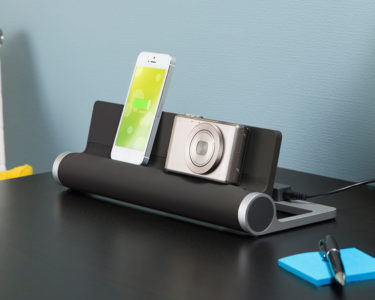I ordered an omelette at my favorite breakfast spot recently, and while I was waiting for my food, I spied a particularly adorable kindergartener out with her parents. But they weren’t really eating breakfast together— while her parents chatted over their eggs and brioche, she sat hunched over an iPad, her eyes transfixed.
As I watched her pancakes get cold, I thought about my own family’s digital habits. I spend (I’m mumbling a number here) hours each day with my eyes transfixed just like that little girl’s, and yet every chance I get I’m barking at my kids to get of those screeeeeens, you guys. The hypocracy is silly, and totally ineffective— after all, children do what they see you do, rather than what you tell them to do, for the most part. Clearly, I’m not suggesting that everyone toss their laptops into the sea, and that children be forbidden to interact with computers; I spend a lot of time exalting the benefits of a life run on technology, and love that my kids are computer literate. I’m also not suggesting that I’ve never handed one of my children an iPad to pacify a child at a dinner table, or during a car ride— I have for sure. That said, I’m becoming more and more aware that my own digital example needs improving, and that our family as a whole needs to do more switching off.
excess screens
As you might expect, I get sent a lot of things to test, and as a result, there is a glut of media and screens in my house. Everywhere you turn, there’s temptation to log on and zone out. As a result, I have never added screens to my car, or kitchen, or my children’s bedrooms. And while my kids are pretty good rule followers and I’ve never caught them on their personal devices after dark, I think it might finally be time to ban their personal devices from the bedroom. They’re isolating enough no matter where you use them, so it might as well be in a communal room, like the family room, with other humans around. This is not lost on my kids, who constantly remind me that their friends can watch DVDs in the car, or TV in their room. And that familiar whine becomes a jumping off point for how those screens would wipe out our fiercely-competitive “Spot the Mustang” car game, or our bedtime backgammon tournaments. In the end, they might not be happy the result, but they understand that I’m trying to protect our family interactions, and hopefully the message lands.
what’s really important
I once had a parent confide in me that she feels important when her phone rings, or she gets a text— it’s a little nugget of validation that she’s loved, or wanted in some way. She admitted that she always answers her phone, and I wondered how often her kids had to play second fiddle to whomever sought her attention. I think about my own children too— how often are they waiting for me to wrap something up on my smartphone or laptop, and what message are they taking away? I’ve written about digital etiquette, and my kids know about no-phone zones such as movie theaters and any other place where their gadgets could disturb someone. But that still leaves a lot of time when the family is sharing physical space, but not head space. We’re sitting side by side, but someone (often me) is juuuust finishing something up or hang on a sec, I need to take this quick call. In her book, The Happiness Project, Gretchen Rubin quotes poet Pierre Reverdy: “There is no love; There are only proofs of love.” It’s a sobering quote, as I contemplate all the proofs I squander by putting interactions on screens above interactions with the humans I love. I have resolved to make more of an effort to show my kids that they are my priority, by putting more boundaries around my own screentime, so I can authentically set boundaries around theirs.
the not knowing
For the most part, screens at mealtimes are a no-no. Except when one of us forgets the lyrics to Bohemian Rhapsody, or has a question about meteorology, or wonders whether Super Mario has a last name or not (yes, this is what we talk about over dinner). Unable to cope with the not-knowing, we grab a smartphone or tablet and Google is there to assuage our discomfort. But what are we losing when we rush to find those answers? And what are we (not) teaching our kids about the importance of deep thought, debate, and the motivation that comes from having to uncover answers over time? Moreover, what am I teaching my kids about good digital boundaries when my “no devices at the table” rule can be bypassed selectively when we must have an insta-answer? Because, let’s face it, once you find out that Mario doesn’t have a last name (I know you were wondering), you usually steal a quick check of your Instagram feed, respond to a quick or text… and before you know it your family is clearing the dishes and you’ve squandered your time together for no good reason. In the past, I’ve fooled myself into thinking it’s a noble cause (the quest for knowledge!), but I’m thinking that having the discipline not to leave the presence of your family at dinner might be a far greater gift.
Final thought
I don’t pretend to have the answers about how much screen time is enough for your kids— it’s a personal decision that depends so much on each child, their age, their interests and your personal values. I think, as parents, we all know what feels like too much, and we know that most things are okay in moderation. But why is it so hard to be moderate? I ask this from behind my laptop, smartphone close at hand— an image my kids see all the time, by the way. If we can’t abstain from the digital all-you-can-eat buffet, what can we expect from the generation that was born into it? How can our kids learn to balance their digital and real lives if we struggle to?
As I left the restaurant, I thought about how screens are invading every aspect of life (I have, just in the last month, written about backyard TVs, shower TVs, tablets on pottys, and tablet mounts for your headboard). I also thought about all the times I’ve succumbed to pressure to give my kids a device at a meal or in a social situation. Like the rest of their upbringing, it’s up to me to enforce boundaries, and model good behavior, so that their digital interactions don’t outweigh the real-life ones. If I don’t, I might have a quieter breakfast here and there, but it will come at a cost.
How do you handle tech in your family? Share your ideas in the comments!




